Guide H-338
Gill Giese, Ciro Velasco-Cruz, and Michael Leonardelli
College of Agricultural, Consumer and Environmental Sciences, New Mexico State University
Authors: Respectively, Extension Viticulture Specialist, Department of Extension Plant Sciences, New Mexico State University (NMSU); Visiting Scientist (Statistical Analysis), NMSU; and Extension Enology Associate (retired), University of Missouri–Columbia. (Print Friendly PDF)
What is Phenology?
Phenology defines growth and development that are related to climatic factors, and that recur periodically in plants and animals. The word “phenology” comes from the Greek terms phainesthai, meaning “to appear,” and logos, meaning “knowledge.” Grape growers use phenology to track, recognize, understand, and describe the annual growth and developmental stages of the grapevine. The Eichhorn-Lorenz (E-L) system is a standardized way to describe phenological growth stages of grapevines (Figure 1). This knowledge provides the basis for decision-making in vineyard site evaluation and selection; choice of cultivar and rootstock; timing of spraying, fertilization, vineyard floor, and canopy management; and harvest.

Figure 1. Seasonal grapevine phenological development. (Adapted from the modified Eichhorn-Lorenz system, based on “Grapevine growth stages, the modified E-L system,” in Coombe and Dry, 2004.)
Grapevine phenology includes two distinct developmental cycles: vegetative and reproductive (flowering and fruiting). The vegetative cycle takes one growing season to complete. Conversely, the reproductive cycle requires two seasons, with flower inflorescences formed in year one, followed by flower initiation, bloom, and fruiting in year two (Figure 2). Or, as simply described by Keller (2010), “Buds formed in the first year, give rise to shoots carrying fruit in the second year” (p. 68).
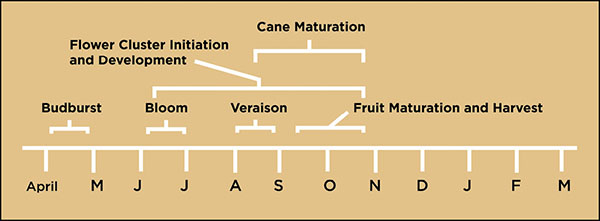
Figure 2. Annual cycle of grapevine growth (figure by Hellman, 2003).
In the first season, flower inflorescences form within the primary compound buds; these emerge in the second season as flower clusters, which are visible on the new shoots. These inflorescences give rise to flower clusters, which bloom and set grape berries that are eventually harvested. For example, the number and size of flower clusters initiated in 2020 depends on the number of inflorescences formed within the dormant buds during the 2019 season (year one). However, the number of flowers that bloom in 2020, set berries, and achieve ripeness within each cluster is impacted by the environment during the 2020 season (year two).
Effects of Climactic Factors on Grapevines
Temperature/heat and light have a large influence on grapevine phenology and production. For example, light exposure is critical to form flower clusters within young buds. In regards to heat, a heat summation system developed in the 1940s can be used to assess regional suitability for grape production. After budburst, when sustained temperatures are above 50°F, the accumulation of heat units or growing degree days (GDDs) begins. A “base” temperature of 50°F is used because it is the temperature of active growth in most temperate-zone plants. Traditionally, GDD accumulation begins on April 1 and ends on October 31 in temperate regions of the northern hemisphere. These GDDs are determined by calculating the average of each day’s high and low temperatures minus 50°F. For example, if the average daily temperature for April 27 is 60°F, one would subtract the base temperature 50°F to arrive at 10 GDDs for the day. A negative daily GDD calculation indicates 0 GDD for the day. Each day’s calculations are summed to determine the total GDDs for the month. This calculation is repeated, and monthly GDDs are summed for a total GDD for a given vineyard and year. The GDD system is easily calculated, and provides a starting point for cultivar selection and regional comparison (Table 1).
|
Table 1. Classification of Climatic Regions Based on Growing Degree Days (GDDs) Using Celsius or Fahrenheit Scales (Winkler, 1974) |
||
|
REGION |
Celsius |
Fahrenheit |
|
I |
<1390 |
<2500 |
|
II |
1391–1670 |
2501–3000 |
|
III |
1671–1940 |
3001–3500 |
|
IV |
1941–2220 |
3501–4000 |
|
V |
>2220 |
>4000 |
Bud dormancy, flowering, fruit ripening, leaf senescence, and grapevine cold acclimation are set by day length (amount of light). However, temperature drives and can accelerate plant metabolic processes and growth and development. Growing degree days can usefully correlate temperature with vine growth, and GDD accumulation may be adjusted if warm days and budburst occur in March rather than April. For example, such an adjustment is warranted at southern latitudes similar to Las Cruces, NM (Figure 2). In Las Cruces, the GDD period logically begins March 1 and ends September 30, with a frost-free period that continues into October. Regardless of differences in start and stop dates for GDD accumulation, a greater GDD indicates a relatively warmer growing region. For instance, note the following average annual GDDs for the period 1989–2019: Las Cruces, NM (average 4933 GDD/year, Region V), versus Los Lunas, NM (average 3575 GDD/year, Region IV), and Farmington, NM (average 3230 GDD/year, Region III) (Tables 1 and 2, Figure 3).
|
Table 2. Growing Degree Day (GDD) Summaries at Three New Mexico Locations (average and median GDDs, maximum and minimum GDDs, and respective years of GDD maximums and minimums by month and year, (1989–2019) |
|||||||||
|
Farmington, NM |
|||||||||
|
April |
May |
June |
July |
August |
Sept |
Oct |
Season Total |
||
|
Average |
122 |
338 |
612 |
769 |
718 |
497 |
174 |
3230 |
|
|
Median |
107 |
351 |
617 |
776 |
712 |
507 |
172 |
3246 |
|
|
Maximum |
215 |
466 |
735 |
864 |
791 |
595 |
276 |
3656 |
|
|
Max Year |
2002 |
2006 |
2016 |
2018 |
2007 |
1998 |
2015 |
2018 |
|
|
Minimum |
17 |
167 |
491 |
656 |
635 |
345 |
93 |
2833 |
|
|
Min Year |
2008 |
2019 |
1998 |
1995 |
1999 |
2006 |
2013 |
1999 |
|
|
Los Lunas, NM |
|||||||||
|
April |
May |
June |
July |
August |
Sept |
Oct |
Season Total |
||
|
Average |
195 |
438 |
652 |
780 |
741 |
546 |
222 |
3575 |
|
|
Median |
191 |
439 |
662 |
786 |
747 |
547 |
219 |
3601 |
|
|
Max |
306 |
545 |
725 |
822 |
802 |
638 |
327 |
3837 |
|
|
Max Year |
2002 |
2006 |
2015 |
2011 |
2011 |
1998 |
2003 |
2012 |
|
|
Min |
96 |
316 |
569 |
680 |
639 |
422 |
78 |
3315 |
|
|
Min Year |
1998 |
2019 |
1995 |
1995 |
1992 |
2006 |
1994 |
1995 |
|
|
Las Cruces, NM |
|||||||||
|
March |
April |
May |
June |
July |
August |
Sept |
Oct |
Season Total |
|
|
Average |
195 |
371 |
618 |
806 |
908 |
880 |
720 |
435 |
4933 |
|
Median |
196 |
363 |
612 |
812 |
917 |
876 |
730 |
418 |
4955 |
|
Max |
331 |
496 |
729 |
872 |
948 |
944 |
818 |
559 |
5263 |
|
Max Year |
2017 |
2002 |
2006 |
2013 |
2016 |
2011 |
2015 |
2016 |
2003 |
|
Min |
76 |
223 |
537 |
712 |
853 |
791 |
583 |
365 |
4497 |
|
Min Year |
2010 |
2008, 2009 |
2019 |
2004 |
2008 |
2004 |
2006 |
2006 |
2008 |

Figure 3. Comparison of growing degree days (GDDs, base temperature 50°F) at three New Mexico locations. March 1 to October 31 for Fabian Garcia Agricultural Science Center (ASC), Las Cruces, Doña Ana County, elev. 3,887 ft; and April 1 to October 31 for Los Lunas ASC, Valencia County, elev. 4,840 ft, and Farmington, ASC, San Juan County, elev. 5,623 ft, 1989–2019. *Horizontal arrows = average GDD at each location.
In temperate zones with cold winters, grapevines actively grow from March/April to October/November, i.e., “the growing season.” Typically, no frost events occur during the growing season and temperatures remain above 50°F. A cultivar’s ability to successfully ripen fruit during the growing season is critical, and most wine grape cultivars require 155–200 frost-free days to reach harvest maturity. Additionally, some post-harvest frost-free days are required for the vines to build up reserve carbohydrates prior to dormancy. Interestingly, despite the different latitude and elevation of Farmington (36.69°N, -108.31°W; 5,623 ft) and Los Lunas (34.77°N, -106.76°W; 4,840 ft), the average number of frost-free days recorded at each location was similar from 2001–2019: Los Lunas had 170 days and Farmington had 164 days (Figure 4). Such region-specific knowledge is critical to successful vineyard site evaluation and cultivar selection.

Figure 4. Annual number of frost-free days at Fabian Garcia Agricultural Science Center (ASC), Las Cruces, Doña Ana County, elev. 3,887 ft; Los Lunas ASC, Valencia County, elev. 4,840 ft; and Farmington, ASC, San Juan County, elev. 5,623 ft, 1989–2019.
Temperature/heat is important for phenological tracking of vine growth. But what’s the importance of light and leaf exposure to the practicing winegrower? In a word: photosynthesis, a metabolic process driven by incident light on leaves, which impacts the yield of your vines and, ultimately, the quality of your wine. As mentioned earlier, light is crucial for flower cluster initiation and fruit set. Light, in conjunction with heat, directly impacts grape color, flavor, and aroma—key factors in wine quality. The specific amount of light, the timing of its occurrence, how it interacts with heat, and how growers can manage it to improve grapevine growth and grape quality are being actively investigated in other regions. In New Mexico, the percent of cloudy days rarely exceeds 33%, and the average number of cloudy days for May through October is 25% or less (Table 3). Clearly, there is adequate sunlight available for photosynthesis in vineyards in New Mexico. Often, overexposure (excessive light and heat) that causes sunburned fruit with lowered quality is not uncommon in New Mexico (Figure 5).
|
Table 3. Average Percent of Cloudy Days by Growing Season Month (cloud cover for 75% of day) at Several New Mexico Locations |
||||||||
|
Station |
April |
May |
June |
July |
August |
Sept |
Oct |
Avg |
|
Albuquerque–NOAA |
27% |
21% |
13% |
15% |
17% |
18% |
19% |
19% |
|
Clayton–NOAA |
32% |
34% |
21% |
22% |
20% |
23% |
21% |
25% |
|
Roswell–NOAA |
23% |
19% |
10% |
17% |
19% |
31% |
23% |
20% |
|
Average |
27% |
25% |
14% |
18% |
19% |
24% |
21% |
21% |
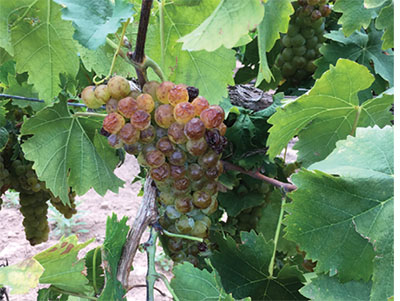
Figure 5. Overexposed, sunburned cluster of Chardonnay grapes (bronzing of individual berries) near harvest in a vineyard near Las Cruces, NM.
Vegetative Growth and Development—Building the Vine's Architecture
Like most temperate zone deciduous fruit crops, grapevines require a chilling period (hours below 45°F) during dormancy for optimal budburst the following spring. The chilling requirement for grapevines is approximately 250 hours, but varies by cultivar and site. Most New Mexico vineyard sites accumulate well over 250 chilling hours. For instance, from November 1, 2017, through February 28, 2018, hours below 45°F were 1035, 1667, and 2093, respectively, for Las Cruces, Los Lunas, and Farmington.
Following budburst, shoot growth is slow during the cool days of early spring; however, by late April/early May, temperatures rise and shoots grow rapidly. During this period of rapid growth or “grand period of growth,” shoots can grow 10–12 inches per week, fueled by carbohydrates stored in the perennial, woody structure of the vine’s trunk, cordons, and roots. Shoot thinning is most advantageous if done at this time, when they are growing very fast and are relatively easy to remove. If this window is missed, the shoots lignify (become woody and turn brown) and the thinning process requires much more effort. This is an example of effective canopy management that depends on the correct interpretation of vine phenology.
Shoot growth over time, or rate of shoot growth, known as “vine vigor,” generally slows after flowering and berry set, but some shoot growth continues all season. However, substantial and continued shoot growth later in the season is not desirable because it can contribute to a dense canopy and less than optimal fruit exposure. After berry set, the leaves produce and export carbohydrates to support the current year’s growth and build reserves for the next year. Grapevine shoots begin to lignify as the grapes begin to ripen. This start of ripening is called “veraison,” when the grapes soften, turn color, and begin to express varietal flavors and aromas. After harvest, leaves begin to senesce (breakdown of the green pigment, chlorophyll, and reallocation of nutrients) by early fall, before the first frost, as the vine prepares for dormancy. Following leaf fall, the lignified, brown shoots are called “canes.”
Grapevine shoots/canes have two types of buds: primary and lateral. The primary bud is formed in the leaf “axils,” where the leaf attaches to the shoot. These compound buds remain dormant until the following year. Each compound bud contains three individual, simple buds or growing points. Two of these growing points contain a young shoot complete with leaves and clusters. The primary growing point is typically the most fruitful, followed by the secondary growing point; the third growing point is usually non-fruitful. Lateral or “prompt” buds also develop in the leaf axils and grow in the season in which they were formed. Occasionally, a “second” crop develops on lateral shoots, but lags well behind the main crop in degree of ripeness, and these clusters are not usually harvested.
Grapevine leaves constitute the grapevine’s “canopy.” The leaves on lateral shoots can make up 20–50% of the vine’s total leaf area. However, excessive lateral leaves can contribute to shading and restrict air flow within the vine canopy, which can increase foliar disease pressure and potentially reduce berry quality. This is a practical reason for canopy management, including leaf removal, canopy hedging, and shoot thinning/positioning. The amount of leaf area needed for New Mexico is likely quite different compared to more cloudy regions with less intense sunlight during the growing season. Greater total leaf area may be needed for photosynthesis and sugar accumulation in cloudy/humid regions compared to arid and semiarid regions. Growers in humid regions often remove leaves in the fruit zone to minimize shading and disease. However, in New Mexico, the amount of vine leaf area and density for optimal berry quality and prevention of sunburned fruit has not been quantified.
Unlike many other temperate zone fruit crops, grapevines do not form terminal buds in the fall. With no terminal bud, the grape cane eventually lignifies, which cuts off the vascular tissue, and the cane tip simply dies back or is pruned back to a node (Figures 6A–C).
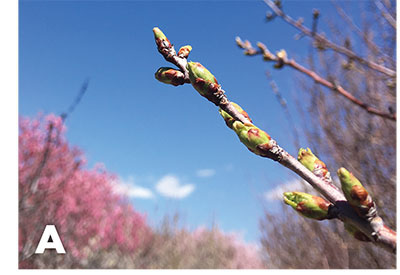
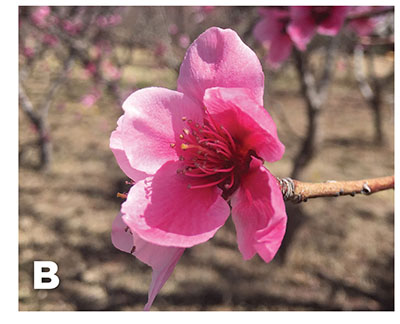

Figures 6A–C. Terminal bud of peach (A), terminal bud peach blossom (B), and grape cane pruned back to a bud just prior to budburst in the spring (C).
Young vines with no crop and vines growing in deep soils with optimal levels of water, nutrients, and sufficient heat can continue growing into the fall and are subject to damage by early frost. Early ripening cultivars, harvested in August or September, are subject to the same situation when their vegetative growth continues into the fall. In the first case, early leaf drop will prevent the production and storage of carbohydrate reserves in the permanent parts of the vine; in the second case, if the canopy is damaged by an early fall frost event, the fruit will not optimally ripen.
Reserves of starch and sugar (carbohydrates) from photosynthesis supply energy for early shoot elongation, diameter increases of older vine parts, flower development, and root expansion. However, the amount of stored carbohydrates available in the subsequent spring can be reduced by premature leaf drop in the fall, as well as over-cropping, drought, nutrient deficiency, and insect and/or disease damage in the previous season. Maintaining healthy leaves during the post-harvest period is important so vines can produce reserve carbohydrates needed when growth resumes the following spring.
Reproductive Growth and Development—the Production of Fruit
Cluster primordia (uncommitted meristems or tissue that give rise to inflorescences or tendrils) initiation for next year’s flower clusters and crop occurs simultaneously with bloom for the current crop—in other words, at the same time. As mentioned earlier, flower clusters emerge with shoots in the spring. These clusters continue to develop over 6–8 weeks until they are ready to bloom. Flower opening or “bloom” typically occurs when temperatures reach about 68°F, just as shoot growth is typically slowing down. The average date to achieve average temperatures of 68°F was April 15 for Las Cruces, May 9 for Los Lunas, and May 17 for Farmington (Table 4).
|
Table 4. Average Date on which Average Daily Temperature of 68°F Was Reached for Three New Mexico Sites for the Period of 1989–2019 |
|||
|
Average Date |
Earliest |
Latest |
|
|
Las Cruces |
April 15 |
March 26, 2012 |
May 1, 2008 |
|
Los Lunas |
May 9 |
April 25, 1996 |
May 27, 2011 |
|
Farmington |
May 17 |
May 3, 1992 |
June 2, 2019 |
Overall, the cycle from cluster primordia in year one to flower parts initiation, bloom, fruit set, and harvest in year two is 14–15 months long; thus, a complete reproductive cycle requires two years. During this time, the environment and vineyard management have substantial influence. For instance, the same tissues that form flower clusters can also form tendrils. Whether a flower or tendril is produced depends on the environmental conditions and hormonal regulation within the vine.
The initiation of cluster primordia in compound buds begins at the base of the shoot and progresses to the shoot tip. Most cultivars have one or two clusters per shoot located at the number 4 and 5 node positions from the shoot’s base. However, some cultivars, such as Semillon, Carignan (Keller, 2010), and Petit Verdot, can have three per shoot. Some hybrids, such as Chambourcin and the Vitis × labruscana cultivar Concord, regularly bear more than two clusters per shoot. Other varieties, such as the popular table grape Thompson Seedless and the Italian wine grape Nebbiolo, are more fruitful beyond the typical number 4 and 5 node positions. The node-dependent fruitfulness of a given cultivar should be considered when pruning and training vines.
Temperatures between 68 and 95°F, combined with adequate sunlight striking the leaves above and below a bud on each shoot, promote fruit set in the current year and ensure bud fruitfulness for the next season. Cool, cloudy conditions at bloom can result in poor bud fruitfulness by limiting photosynthesis. Within the dormant bud, inflorescence primordia continue to develop until late summer. At about three months after budbreak, the inflorescences are formed, and by the end of summer, next year’s shoot development is complete with 12–16 leaves within the dormant, compound bud. When dormant buds are dissected under a microscope in early fall, the next season’s clusters are easily visible. Individual flower parts—stamens and pistils—will be formed by bloom the following year.
In addition to stamens (pollen producing) and pistils (stigma, style, ovary), complete grape flowers have a fused petal corolla structure called a “calyptra,” or cap, that opens from the bottom of each individual floret (Figures 7A and 7B). Most grape cultivars are hermaphroditic (contain male and female reproductive structures) and self-pollinating. Anthesis (pollen shed) occurs as the calyptra detaches from the flower base. Under favorable conditions, pollen grains form tubes that grow through the stigma/style tissues and penetrate the ovule, fertilizing the egg. The fertilized egg develops into an embryo sac and forms the seed. One to four seeds occur in seeded grape cultivars. Fruit growth follows fertilization. Thus, pollination and fertilization are not the same process, but can be considered a two-part process. This entire process takes 2–3 days after the initiation of pollination. As many as 1,000 flowers (or florets) are present on a single flower cluster (or inflorescence), and berry set is considered successful if one in three flowers, or 33%, develops into a grape berry. Following fruit set, the remaining flowers shrivel, die, and fall away from the cluster during the initial stages of berry growth. This period is called “shatter” and can last 10–14 days. Detached flower parts that do not fall clear of the cluster can provide substrate for fungi that can eventually rot ripening berries. Flowering and fruit set, modified E-L stages 23–27, are phenological stages widely noted and referred to by vineyard managers (Figure 1).
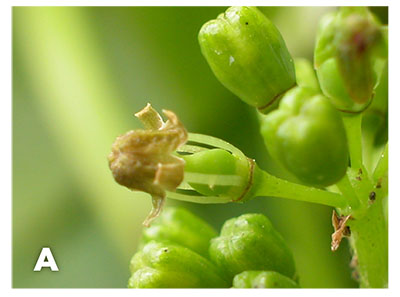
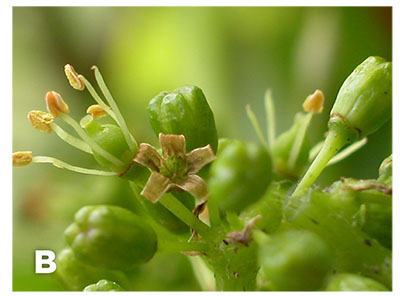
Figures 7A–B. Calyptra or “cap” just after it has detached from the base of the grape flower (A), and has been completely shed from the flower, exposing the stamens and pistil (B).
As mentioned earlier, veraison (modified E-L stage 35, the onset of grape berry ripening), is characterized by berry softening, color change, and increasing sugar content. Veraison begins in mid to late summer, depending on cultivar and climate. In ripening, sugars and other compounds are constructed. Grape berries become “physiologically mature” immediately after veraison, when the seeds are able to germinate. Physiological maturity occurs under 20° Brix, which is a level associated with grapes harvested for sparkling wine (14–18° Brix), i.e., low sugar and high acid. Grapes grown for table wines are usually harvested at Brix levels of 21–24°, depending on the wine style that is traditionally associated with each cultivar. Most red wine styles use grapes harvested on the high end of the scale. Wineries typically have the final say regarding when the fruit will be picked. When harvest occurs much later than normal or optimal, it is associated with dehydrated berries or worse, and is sometimes referred to as “hang-time”. Regardless, allowing grapes to remain on the vine for extended periods to achieve enhanced berry flavor, aroma, and color for a desired wine style should be weighed against the potential cons: exposure of the grapes to predators, disease, late season rains/frost, excessive solar exposure, loss of juice yield due to berry shrivel, and unbalanced fruit chemistry due to increased pH (the concentration of H+ ions or “effective acidity”) and decreased acidity (measured by simple acid/base titration, titratable acidity or “TA,” expressed as grams of tartaric acid per liter in the United States).
Decreased day length in the fall (in the northern hemisphere) triggers leaf senescence, which typically begins on the same day for a given cultivar and latitude. In contrast to ripening, senescence results in proteins and other compounds being deconstructed. However, senescence will slow down in cool years and speed up in warm years (temperature effect). Senescence, or “planned death” in leaves, occurs as green-colored chlorophyll is broken down, yellow-orange carotenoid pigments are revealed, and leaves turn from green to yellow, signaling the end of the growing season.
Further Reading
Dokoozlian, N. 2000. The cycle of vine growth. University of California Extension, Varietal Winegrape Production Short Course.
Jackson, R.S. 2000. Wine science: Principles, practice, perception, 2nd ed. San Diego, CA: Academic Press, Elsevier Science.
Keller, M. 2010. The science of grapevines: Anatomy and physiology. London, UK: Elsevier Inc.
Wolf, T.K., J.D. Boyer, T.E. Martinson, and F.A. Westover. 2008. Vineyard site selection. In T.K. Wolf (Ed.), Wine grape production guide for eastern North America (pp. 14–36). Ithaca, NY: Plant and Life Sciences Publishing.
References
Gladstones, J. 1992. Viticulture and environment. Adelaide, Australia: Winetitles.
Hellman, E.W. 2003. Grapevine structure and function. In E. Hellman (Ed.), Oregon viticulture (pp. 5–19). Corvallis: Oregon State University Press.
Lombard, K., B. Maier, F.J. Thomas, M. O’Neill, S. Allen, and R. Heyduck. 2013. Wine grape cultivar performance in the Four Corners region of New Mexico in 2010–12. HortTechnology, 23, 699–709.
Pearce, I., and B.G. Coombe. 2004. Grapevine phenology. In P.R. Dry and B.G. Coombe (Eds.), Viticulture, volume 1: Resources, 2nd ed. (pp. 150–166). Broadview, South Australia: Winetitles.
Smart, R.E., and M. Robinson. 1991. Sunlight into wine: A handbook for wine grape canopy management. Adelaide, Australia: Winetitles.
Vogel, S. 2012. The life of a leaf. Chicago: University of Chicago Press.
Winkler, A.J., J.A. Cook, W.M. Kliewer, and L.A. Lider. 1974. General viticulture. Berkeley: University of California Press.
Summary of Phenology: The Annual Grapevine Growth Cycle
There are four major stages of grapevine growth and associated descriptions within the modified Eichhorn-Lorenz system:
1. Budburst, E-L stage 4: Leaf tissue visible.
a. Grapevines leaf out relatively late compared to most perennial fruit crops.
b. Root growth occurs after budburst, which impacts fertilizer application timing.
c. “Grand period” of growth after budburst; shoots grow 10–12 inches/week.
d. Flower clusters emerge with shoots; flower parts form over 6–8 weeks.
2. Flowering, E-L stage 23: Bloom occurs when temperatures are >68oF.
a. Next year’s flowers initiated at bloom, and shoot growth slows.
b. Continued shoot growth and berry development.
3. Veraison, E-L stage 35: Berries soften, form sugars, and change color; canes lignify.
4. Harvest, E-L stage 38: Desired sugar level achieved (typically >20o Brix).
a. Young and early harvested vines that continue growth into the fall can be damaged by early frost.
b. After harvest, leaves build reserves for growth the following spring.
c. Leaves senesce and fall.
For Further Reading
H-303: Pruning Grapes to the Four-Arm Kniffin System
pubs.nmsu.edu/_h/H303/
H-309: Grape Varieties for North-central New Mexico
pubs.nmsu.edu/_h/H309/
H-322: Propagation of Grapevine Cuttings: A Practical Guide
pubs.nmsu.edu/_h/H322/
H-331: Trellis End Post Assembly Designs for Vineyards
pubs.nmsu.edu/_h/H331/

Gill Giese is the Extension Viticulture Specialist and Assistant Professor at NMSU. He earned his Ph.D. at Virginia Tech, and has worked as a commercial winemaker and viticulture/enology instructor. His applied research and Extension work focuses on variety/rootstock evaluation, mitigation of frost/cold damage, soil issues, insects and nematodes, and trellising options to optimize grape yield and berry composition in New Mexico and the arid Southwest.
To find more resources for your business, home, or family, visit the College of Agricultural, Consumer and Environmental Sciences on the World Wide Web at pubs.nmsu.edu.
Contents of publications may be freely reproduced, with an appropriate citation, for educational purposes. All other rights reserved. For permission to use publications for other purposes, contact pubs@nmsu.edu or the authors listed on the publication.
New Mexico State University is an equal opportunity/affirmative action employer and educator. NMSU and the U.S. Department of Agriculture cooperating.
August 2020 Las Cruces, NM


